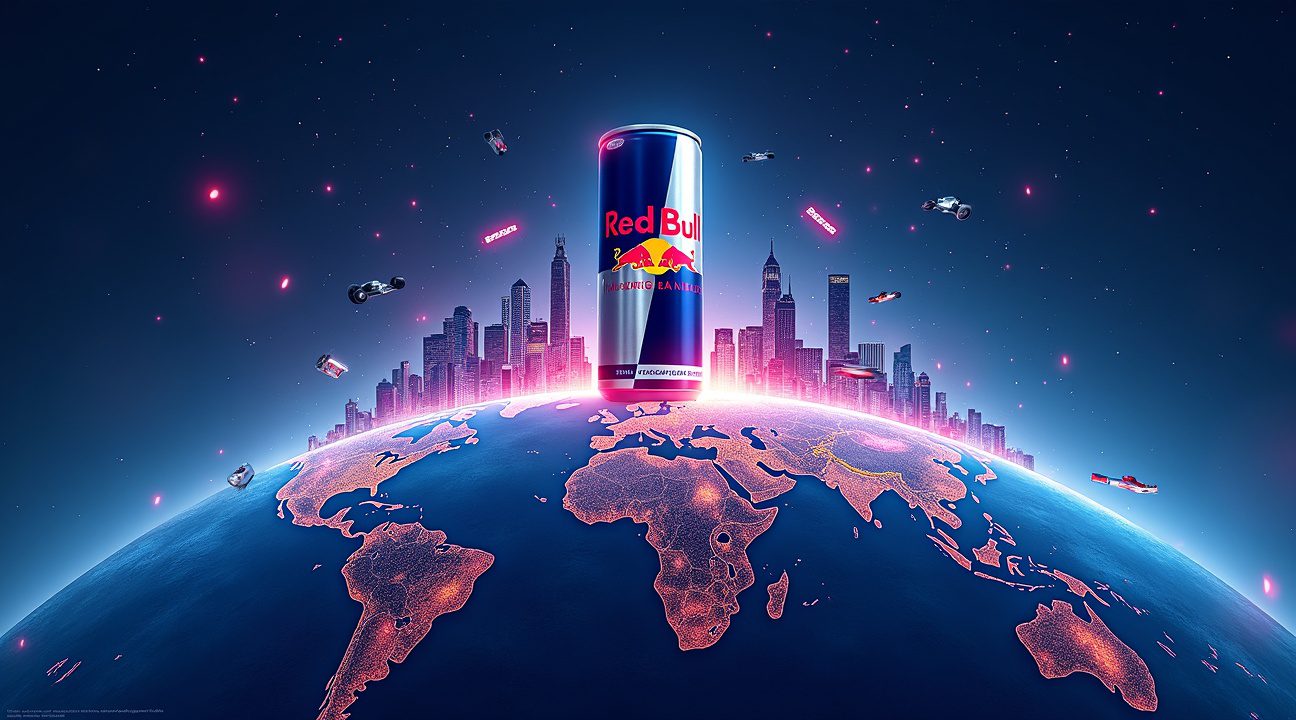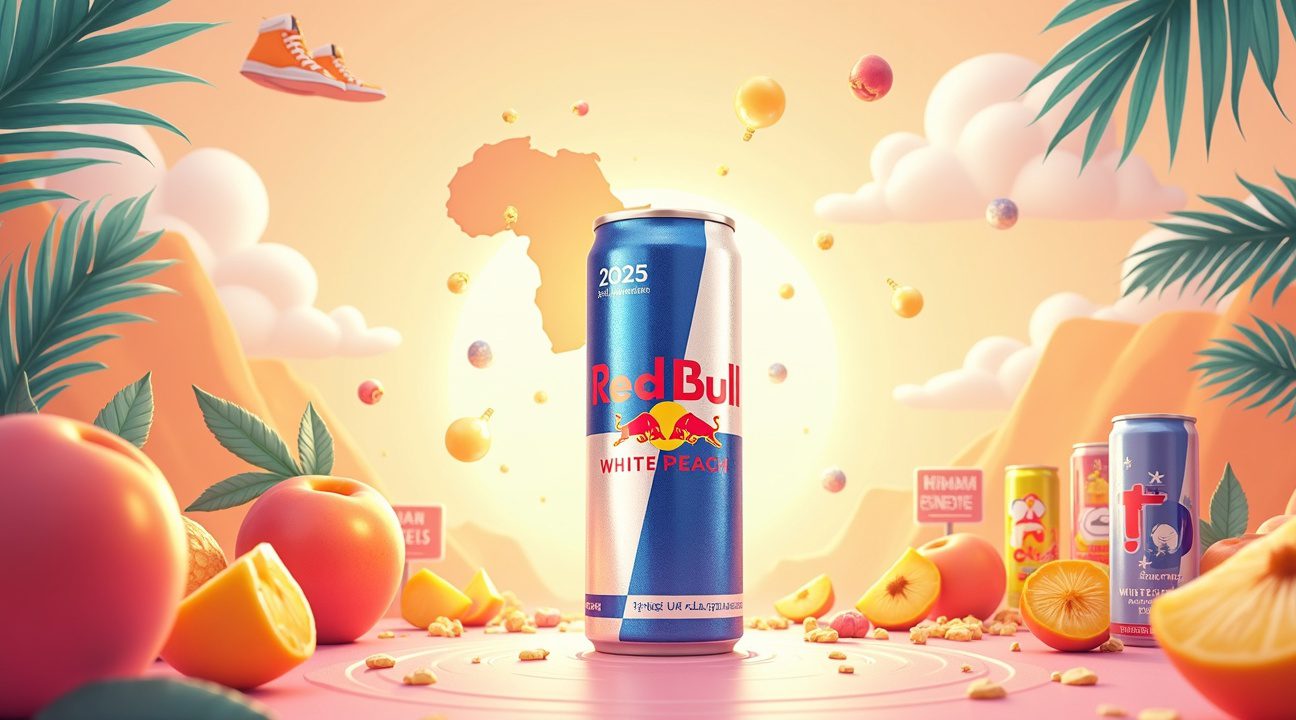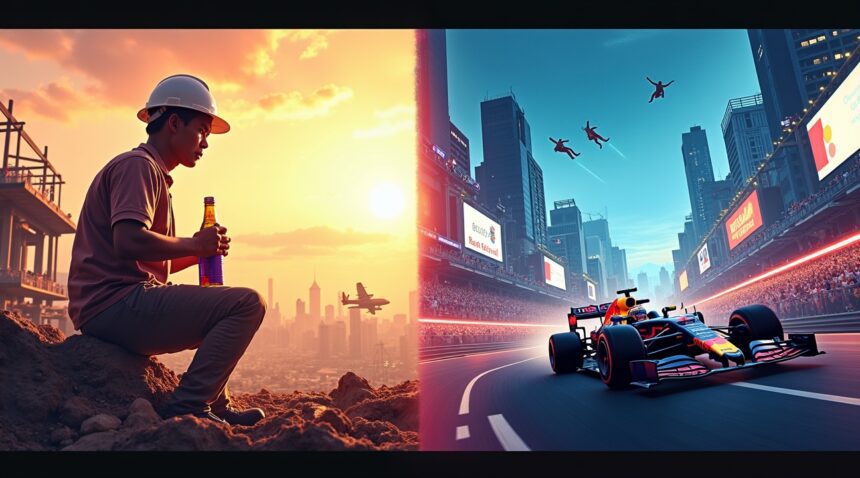Red Bull’s transformation from a Thai construction worker’s energy tonic called ‘Krating Daeng’ into a €10.55 billion global empire represents one of business history’s most remarkable success stories.
The partnership between Thai businessman Chaleo Yoovidhya and Austrian entrepreneur Dietrich Mateschitz in 1984 created not just a beverage brand, but an entirely new market category that now commands 40% of the global energy drink market across 171 countries.
Key Takeaways
- Strategic reformulation was crucial – Red Bull succeeded by adapting the original Thai formula for Western tastes rather than simply exporting the existing product unchanged.
- Marketing investment drives dominance – The company allocates €3 billion annually (25-30% of revenue) to experiential marketing, sponsorships, and cultural events rather than traditional advertising.
- Focus beats diversification – Red Bull’s unwavering commitment to energy drinks, rather than expanding into multiple beverage categories, enabled deeper market penetration and premium pricing power.
- Family ownership enables long-term strategy – The 51/49 ownership split between the Chalerm Yoovidhya and Mateschitz families provides stability and consistent decision-making without quarterly profit pressures.
- Limited edition innovation maintains excitement – Strategic product releases like seasonal flavors and regional exclusives generate consumer engagement while staying within the core energy drink category.
Red Bull’s success stems from recognizing an untapped market opportunity and executing a focused strategy that prioritizes brand building over short-term profits. The company discovered that Western consumers wanted an energy boost but preferred a lighter, more carbonated formula than the original Thai version. This insight drove the reformulation that made Red Bull palatable to global markets.
The brand’s marketing approach revolutionized how companies connect with consumers. Instead of traditional advertising, Red Bull invests heavily in extreme sports sponsorships, music festivals, and content creation. This approach builds authentic relationships with target audiences and positions the brand as a lifestyle enabler rather than just a beverage.
Its unwavering focus on a single product category has allowed Red Bull to maintain premium pricing and market leadership. Unlike competitors that diversify, Red Bull perfects its energy drink formula and applies strict quality control, which deepens brand loyalty and recognition.
Red Bull’s ownership structure is also a key to its strategic consistency. With a 51/49 split between the Yoovidhya and Mateschitz families, the company avoids the pressure of satisfying public shareholders. Instead, it prioritizes long-term investments in brand and product developments.
Product innovation at Red Bull focuses on excitement without fragmentation. Seasonal flavors and region-specific versions attract attention while preserving the brand’s core identity. These limited editions build momentum and keep the consumer base engaged with the brand.
The company’s retail strategy ensures premium placement and price consistency. By selecting retail partners carefully and avoiding heavy discounting, Red Bull protects its premium perception in the market.
Red Bull’s content creation efforts are tightly integrated with brand strategy. From documentaries to extreme sports coverage, the company produces engaging content that not only promotes the brand but also creates new revenue streams—a rare feat in marketing.
Global expansion is a calculated process at Red Bull. Entering new markets involves extensive research into consumer behavior, legal standards, and competitive environments. This methodical approach lowers the risk of failure and promotes sustainable scalability.
Company culture is another strong point. Employees are selected based on their alignment with the brand’s adventurous essence. Red Bull offers growth opportunities and fosters an energetic work environment that mirrors its brand ethos—strengthening employee connection and brand authenticity.
Supply chain management remains rigorous. Red Bull ensures quality and consistency worldwide while adapting to local regulations. This balance supports brand trust and compliance without compromising the core identity.
Pricing strategy also plays a critical role. Red Bull avoids low-price competition and focuses on value-through-experience, maintaining its premium image while remaining accessible to its target market.
The brand’s digital strategy complements its experiential campaigns. Through shareable videos, social media content, and event tie-ins, Red Bull amplifies its marketing reach and fosters community among its loyal consumers.
Ultimately, Red Bull’s rise showcases the power of focused execution over diversification. With aligned marketing, strict product discipline, and the stability offered by family ownership, the company has built a brand that competitors find nearly impossible to match. It stands as a powerful example of how understanding consumers and staying on strategy can yield extraordinary success in even the simplest product categories.
From Thai Labor Tonic to €10.55 Billion Empire: The Unlikely Global Success Story
Red Bull’s extraordinary journey began in the most unexpected place—Thailand’s construction sites and factories. Chaleo Yoovidhya, a Thai businessman, originally developed ‘Krating Daeng’ as a simple tonic drink designed to help manual laborers stay alert during grueling work shifts. This humble beginning couldn’t have been further from the global empire the brand would eventually become.
The Austrian Connection That Changed Everything
The transformation from local labor tonic to international phenomenon started in the early 1980s when Austrian entrepreneur Dietrich Mateschitz discovered Krating Daeng during a business trip to Thailand. Unlike most visitors who might have simply enjoyed the drink and moved on, Mateschitz recognized the untapped potential for international markets. He understood that Western consumers had no equivalent product and saw an opportunity to introduce an entirely new beverage category.
In 1984, these two unlikely partners formed Red Bull GmbH, marking the beginning of what would become one of the most successful brand transformations in business history. The partnership proved crucial because it combined Chaleo’s original formula and local market knowledge with Mateschitz’s vision for global expansion and understanding of Western consumer preferences.
Strategic Reformulation and Market Creation
The key to Red Bull’s success wasn’t just taking the original Thai formula and selling it unchanged. Instead, the partners carefully reformulated Krating Daeng to better suit Western taste preferences before launching Red Bull in Austria in 1987. This reformulation proved essential because it created what is recognized as the modern energy drink category—a completely new market segment that didn’t exist before.
The numbers tell the remarkable story of this transformation:
- Available in over 171 countries
- 12.670 billion cans sold globally by 2024, representing a 4.4% increase over 2023
- €10.55 billion in revenue generated in 2023
Looking ahead, projections show continued growth momentum:
- Brand value expected to reach EUR 8.7 billion by 2025
- 11% year-over-year increase forecasted
This trajectory demonstrates how a simple Thai labor tonic became one of the most valuable beverage brands globally, proving that sometimes the most unexpected origins can lead to extraordinary success stories. Much like how pop culture influences lives in unexpected ways, Red Bull’s transformation shows how cultural products can transcend their original boundaries to achieve global impact.

How Red Bull Conquered 40% of the Global Energy Drink Market
Red Bull has secured its position as the undisputed leader in the global energy drink market, commanding an impressive 40% market share that towers above all competitors. This dominance stems from decades of strategic brand building and market expansion that began with a simple Thai energy drink called Krating Daeng.
Market Domination Through Strategic Positioning
The brand’s success becomes even more remarkable when examining specific regional performance. In the United States, Red Bull generated $7.76 billion in sales during 2024, capturing nearly half of the country’s entire energy drink market. This performance demonstrates the brand’s ability to maintain premium pricing while expanding volume, a combination that few consumer goods companies achieve consistently.
Market concentration in the energy drink industry tells an interesting story about brand loyalty and consumer preference. Red Bull, Monster, and Rockstar together control 86.6% of the U.S. market, creating what economists call an oligopoly. This concentration mirrors trends seen in other beverage categories, much like cultural influences that shape consumer preferences across industries.
Competition remains fierce despite Red Bull’s commanding lead. Major players include:
- PepsiCo
- Coca-Cola
- Monster
- Rockstar
- Lucozade
- Dr Pepper Snapple Group
Each of these companies brings significant resources and distribution networks to challenge Red Bull’s supremacy. However, Red Bull’s first-mover advantage and consistent brand messaging have created substantial barriers for competitors attempting to capture market share.
The global energy drink industry’s trajectory points to continued expansion, with projections indicating the market will reach $115.85 billion by 2030. This growth represents a compound annual growth rate of 6.75%, significantly outpacing traditional soft drink categories. Red Bull’s established position allows the company to capture a disproportionate share of this growth while maintaining pricing power.
Regional growth patterns reveal where Red Bull’s future opportunities lie:
- India: 30% annual growth
- Brazil: 22% annual growth
- Eastern Europe: 22% annual growth
These markets represent untapped potential for Red Bull’s premium positioning strategy, particularly as rising disposable incomes create demand for branded energy products.
Red Bull’s market dominance isn’t merely about product placement or distribution reach. The company has created an entirely new category of functional beverages while simultaneously building a lifestyle brand that resonates across demographics. This dual approach has proven remarkably effective in maintaining market leadership despite increased competition from well-funded challengers.
The brand’s ability to maintain over 40% global market share while facing pressure from multinational beverage giants demonstrates the strength of its positioning strategy. Unlike traditional beverage companies that compete primarily on price and availability, Red Bull has built consumer loyalty through consistent product quality and innovative marketing approaches that extend far beyond conventional advertising.
Market data suggests Red Bull’s dominance isn’t showing signs of weakening despite intensifying competition. The company continues to expand into new geographic markets while defending its position in established territories. This expansion strategy, combined with product innovation and brand extensions, positions Red Bull to benefit from the energy drink industry’s projected growth through 2030.
Understanding Red Bull’s market conquest provides insights into how focused brand strategy can create sustainable competitive advantages. The company transformed a regional Thai product into a global phenomenon by consistently delivering on brand promises while expanding market reach through strategic partnerships and distribution agreements. This approach has created a business model that competitors find difficult to replicate, ensuring Red Bull’s continued dominance in the rapidly growing energy drink sector.

The €3 Billion Marketing Machine That “Gives You Wings”
Red Bull’s transformation from a regional Thai beverage into a global phenomenon didn’t happen through conventional advertising tactics. I’ve observed how the company revolutionized energy drink marketing by allocating an estimated €3 billion annually to marketing efforts—representing 25–30% of its total revenue. This investment strategy demonstrates Red Bull’s commitment to brand experience over traditional product promotion.
Beyond Traditional Advertising: Creating Cultural Movements
Red Bull’s approach centers on lifestyle integration rather than direct product advertising. The company’s globally recognized tagline, “Red Bull Gives You Wings”, serves as more than a marketing slogan—it establishes the brand’s core identity around possibility and transcendence. This messaging connects directly with consumers who view the drink as fuel for extraordinary experiences.
The brand’s marketing philosophy focuses on creating authentic connections through extreme sports sponsorship, music events, and cultural initiatives. Red Bull doesn’t simply advertise at events; it creates them. Pop culture influence becomes a natural extension of these carefully crafted experiences, allowing the brand to shape consumer perception through association rather than persuasion.
Strategic Partnerships That Define Excellence
Red Bull’s sponsorship portfolio spans multiple high-energy disciplines, establishing the brand as synonymous with peak performance. The company’s investment in Red Bull Racing within Formula 1 provides global visibility during one of the world’s most-watched sporting events. Similarly, the Red Bull Air Race and Red Bull Cliff Diving World Series showcase the brand’s commitment to extreme athletics that embody its core messaging.
The brand’s athlete sponsorship program operates across 73 countries, supporting individuals who represent Red Bull’s values of pushing boundaries and achieving the impossible. These partnerships extend beyond simple endorsements—Red Bull actively develops talent and creates platforms for athletes to showcase their abilities. The company owns sports teams in soccer, motorsports, and other competitive arenas, further cementing its position within athletic culture.
Red Bull’s content creation strategy includes producing documentaries, live events, and digital content that entertains while subtly reinforcing brand values. Entertainment marketing has proven effective for many brands, but Red Bull’s approach integrates seamlessly with its audience’s interests and aspirations.
Music festivals, art installations, and cultural events round out Red Bull’s marketing ecosystem. These initiatives target youth demographics who value authentic experiences over traditional advertising messages. The brand’s association with creativity and innovation extends its appeal beyond sports enthusiasts to include artists, musicians, and cultural influencers.
Red Bull’s marketing machine operates on the principle that brand loyalty develops through shared experiences and emotional connections. By investing heavily in creating memorable moments rather than purchasing advertising space, the company has built a marketing model that competitors struggle to replicate. This approach requires significant financial commitment but generates returns through increased brand recognition, customer loyalty, and premium pricing power.
The company’s marketing budget allocation reflects a fundamental understanding that modern consumers, particularly younger demographics, respond more favorably to brands that enhance their lifestyle rather than interrupt it with traditional advertisements. Red Bull’s €3 billion investment creates a continuous cycle of brand reinforcement through multiple touchpoints, ensuring the “Red Bull Gives You Wings” message reaches consumers through channels they actively choose to engage with.
Building an €8.7 Billion Brand Through Strategic Focus
Red Bull’s remarkable ascent to an €8.7 billion brand valuation demonstrates how laser-focused strategy can triumph over conventional business wisdom. The company’s impact of pop culture extends far beyond traditional marketing approaches, creating a blueprint that challenges industry norms.
Red Bull’s U.S. valuation soared past $22 billion in 2024, proving that concentrated excellence often outperforms scattered efforts. While competitors diversify their portfolios across multiple beverage categories, Red Bull maintains an unwavering commitment to energy drinks. This singular focus allows the company to pour all resources into perfecting one product category rather than spreading investments thin across various markets.
The brand’s strength speaks volumes about this approach. Red Bull achieved the highest Brand Strength Index among Austrian companies, scoring an impressive 76.8 out of 100. Such performance doesn’t happen accidentally—it results from decades of consistent messaging, quality control, and strategic positioning that keeps energy drinks at the center of everything.
Maintaining Family Control in a Corporate World
Red Bull’s ownership structure reinforces its strategic focus. The Chalerm Yoovidhya family holds 51% of the company, while the Mateschitz family retains 49%. This family-centric ownership model provides stability that public companies often lack. Decision-making becomes faster, long-term vision stays consistent, and quarterly profit pressures don’t dictate strategic direction.
Nearly 20,000 employees worldwide work within this focused framework, each contributing to a singular mission rather than juggling competing priorities. The company’s streamlined approach creates clarity throughout the organization, from product development to marketing campaigns. Everyone understands the core objective: dominating the energy drink market.
Most beverage giants pursue diversification strategies, believing broader portfolios reduce risk. Strategic partnerships and acquisitions often pull these companies in multiple directions. Red Bull chose the opposite path, doubling down on what made them successful initially.
This concentrated approach allows Red Bull to maintain premium pricing while competitors fight price wars across multiple categories. Energy drinks command higher margins than traditional soft drinks, and Red Bull’s brand strength supports pricing power that diversified competitors can’t match in every category they enter.
The company’s global ranking at 238th among all brands worldwide reflects impressive achievement for a business built around a single product category. Brand magic emerges when companies resist the temptation to chase every opportunity and instead become masters of their chosen domain.
Red Bull’s strategic focus extends beyond product development into marketing, sponsorships, and brand experiences. Every initiative connects back to energy drinks and the lifestyle they represent. This consistency reinforces brand identity while competitors dilute their messaging across various product lines.
The family ownership structure supports this long-term thinking. Public companies face constant pressure to show growth across multiple metrics, often leading to hasty diversification decisions. Red Bull’s private ownership allows patient capital allocation, focusing on sustainable growth within their core market rather than quick wins in adjacent categories.
Industry insights reveal that many successful brands lose their way through overexpansion. Red Bull’s restraint demonstrates that saying no to opportunities can be as valuable as saying yes to the right ones.
The €8.7 billion valuation represents more than financial success—it validates a business philosophy that prioritizes depth over breadth. Red Bull’s journey from a Thai energy drink to a global powerhouse proves that strategic focus, combined with exceptional execution, can create extraordinary value in a crowded marketplace.
Limited Edition Flavors and Strategic Product Innovation
Red Bull’s approach to product innovation demonstrates how restraint can be more powerful than expansion. While competitors chase every beverage category imaginable, Red Bull maintains laser focus on what made them famous: energy drinks. This disciplined strategy has paid dividends, allowing the company to perfect their craft rather than dilute their brand across multiple product lines.
The limited edition strategy creates a sense of urgency and exclusivity that drives consumer behavior. Red Bull’s White Peach 2025 Summer Edition generates buzz through scarcity, making each release feel like an event rather than just another product launch. Previous hits like Watermelon and Dragon Fruit from the 2021 Tropical Pink Grapefruit series proved that consumers crave variety within familiar boundaries.
Regional Success Stories Drive Global Strategy
Red Bull’s Mango Pineapple flavor stands as a testament to understanding regional preferences. This bestseller in the Asia-Pacific region demonstrates how the company adapts without abandoning its core identity. The success of regional flavors often influences global rollouts, creating a feedback loop that keeps innovation grounded in consumer reality.
Limited editions serve multiple strategic purposes beyond simple flavor variety. They generate media coverage, social media conversations, and retail excitement without requiring massive infrastructure changes. Each new flavor builds on Red Bull’s existing production capabilities while testing market appetite for different taste profiles. This approach minimizes risk while maximizing engagement, much like how pop culture influences consumer preferences through carefully timed releases.
The company’s narrow beverage portfolio might seem limiting compared to competitors who venture into waters, sodas, and teas. However, this focus allows Red Bull to dominate the energy drink category completely. They’ve become synonymous with energy drinks in the same way that certain entertainment franchises become cultural phenomena through consistent quality and strategic innovation.
Red Bull’s innovation calendar keeps consumers engaged year-round. Seasonal releases create anticipation, while regional exclusives reward local markets. This steady stream of novelty maintains brand freshness without confusing consumers about what Red Bull represents. The strategy proves that sometimes the best way forward is deeper, not wider.

Future Challenges in a Competitive Landscape
Red Bull stands at a crossroads where significant challenges intersect with unprecedented opportunities. Health-related debates continue to intensify as consumers become more conscious about energy drink ingredients and their long-term effects. Regulatory scrutiny has increased across multiple markets, with governments implementing stricter labeling requirements and age restrictions. Inflation impacts have pressured production costs while environmental concerns mount pressure for sustainable packaging solutions.
Strategic Opportunities for Growth
Several pathways present themselves for Red Bull’s continued expansion:
- Health-focused product lines: These represent a natural evolution, allowing the company to capture health-conscious consumers without abandoning its core identity.
- Geographic expansion: Emerging markets offer substantial revenue potential, particularly in regions where energy drink consumption continues to grow.
- Technology integration: Advanced technologies can revolutionize everything from production efficiency to customer engagement.
- Environmental sustainability: Enhanced efforts position the brand favorably with environmentally aware consumers.
The company’s approach to these challenges reflects the same strategic thinking that drives successful ventures across industries, much like pop culture influences shape consumer behavior patterns.
Market Dynamics and Innovation Strategy
Current market dynamics reveal both risks and opportunities that demand careful consideration:
- Copycat brands: These flood the market with lower-priced alternatives, forcing Red Bull to differentiate through innovation rather than price competition. This competitive pressure drives continuous improvement and creative marketing strategies.
- Innovation as a key driver: Red Bull’s ability to anticipate consumer trends and adapt product offerings accordingly is crucial to future success. Innovation must extend from production into marketing, distribution, and customer relationship management.
- Sustainability as strategy: Environmental sustainability efforts aren’t just regulatory compliance measures—they’re strategic investments. Consumers increasingly prefer brands that align with their values, making sustainability a competitive differentiator.
Long-term growth strategies must balance risk mitigation with bold innovation. Red Bull’s established brand strength provides a foundation for experimental product lines and market entries that smaller competitors can’t afford to attempt. This advantage allows for calculated risks that can yield substantial returns while maintaining market position.
The company’s future depends on its ability to evolve while preserving the core elements that built its success. Adapting to regulatory changes, addressing health concerns, and maintaining environmental responsibility positions Red Bull for sustained growth in an increasingly complex marketplace.

Sources:
Brand Finance Press Release (“Red Bull and Erste: Austria’s sole representatives in the Global 500 …”, Jan 2025)
Statista (“U.S. energy drink market share 2025”; “Red Bull – statistics & facts”)
Strategic Management Insight (“Red Bull SWOT analysis 2025”)
Red Bull Company Profile (“Giving Wiiings to People & Ideas”)
Cascade (“The Ultimate Red Bull Marketing Strategy Study”)
Accio (“2025’s Best Selling Red Bull Flavors & Market Trends Revealed”)
Lundquist College of Business (“U.S. Energy Drink Industry Report”)


